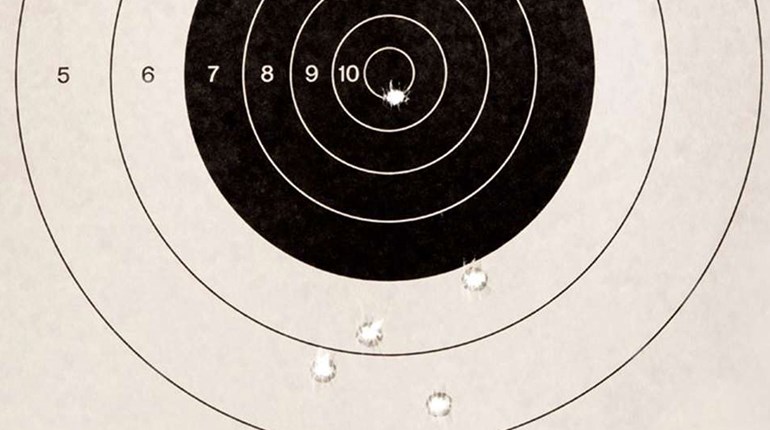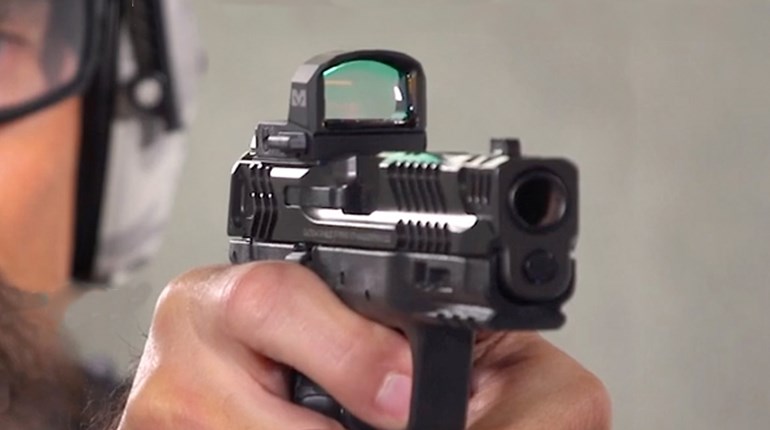
I do not recall a point in my adult life when I had excess time on my hands. The cycle usually begins with a well-planned schedule and ends with things moving at a jaw-clenching, bloodshot-eyes pace. At that point, the temptation to scale back non-critical tasks often erases them from my plan altogether. So, any time I can knock out a little vehicle maintenance, get in a quick workout or even read something that is not work-related is worth its weight in gold to me. The same goes for shooting: After a long day of testing other people’s firearms, I am typically short on “me time”—as in, knocking the dust off of my own guns and skills. This situation came and went with different operational cycles during my Army years, too. My teammates and I relied on simple shooting drills for those periods when task-saturation had us itching for a little range time. Sometimes that meant nothing more than a 25-meter, 10-round slow fire with our 1911s or concealed handguns, and other times we would just show up at a range and shoot whatever steel was already set up with the gun(s) we had on-hand. The 3-2-1 Drill is another great tool for quick, diagnostic shooting and subsequent improvement.
We used this drill primarily for our red-dot or low-/variable-power optics-equipped 5.56 NATO carbines, but it is suitable for any firearm that will reach out a few hundred yards, whether using iron sights or optics. I recommend you use the firearm you would grab if you could only choose one for general-purpose use. No matter if it is a lever-action .30-30 Win., a bolt-action .270 Win. or a semi-automatic pistol chambered for a centerfire-rifle cartridge, the idea is to simply check one’s zero and hold-overs at several key distances without any range preparations beyond setting up something at which to shoot. A cardboard or paper silhouette-size target (approximately 18x36 inches) is preferred so you can check your group sizes and points-of-impact when finished. While this might seem a bit large, the extra target space will serve as a witness panel in the event your zero or downrange holdovers are off slightly.

Binoculars or a spotting scope will allow you to use one target and spot your shots at each firing distance. Sans magnification, three separate targets (one for each distance) may be used, or you can simply hustle down to the target to check your work between each string. The additional workout will be a bonus. A rifle range that has at least 100 yards or meters is required, though 300 is the preferred minimum distance. If you are using a known-distance (KD) range with multiple firing lines, you will literally move to each of the distances mentioned here. The more common, single-firing-line range will require your targets to be set at their respective distances downrange. Check to be sure your downrange target placement does not violate the range’s rules and that your shots will stay well within range limits and backstop(s). You will be shooting prone, kneeling and standing from separate distances, so your angle-of-fire will change as you move. Your firearm of choice should be in its normal “grab-and-go” configuration and if possible, use your go-to ammo as well. Total expenditure will be 30 rounds if you only run the drill once.
The 3-2-1 Drill starts at 300 yards: When ready, drop to a prone position, supporting your rifle on whatever you normally use for field expediency—a bipod, day pack, magazine or elbows. Fire 10 rounds using the appropriate holdover for your cartridge at that distance, aiming to place all 10 shots center mass. This is not a timed drill, but the idea is to approach it with a fighting mindset. Therefore, when your sights are settled on target, break the shot, follow through, cycle the action (if using a manually operated gun) and repeat. Reload firearms with sub-10-round capacities at the required time in order to complete the string. Afterward, check your target to determine where your hits are and either paste them up or make a good mental note of existing shots so you can differentiate them from the remaining ones.
Next, move up to 200 yards (or switch to the 200-yard target on a static range) and take all equipment with you just as you would if you were actually under the gun. If something is too ungainly to carry around (like a PRS-size sandbag strapped to your waist), learn to shoot without it or suck it up and carry it throughout the drill. Once you are set at 200 yards, assume a hasty kneeling position and repeat the process using the appropriate hold, again aiming for center mass. Fire 10 shots, check your target and move to 100 yards.
Once there, remain standing and shoot offhand for a third string of 10 shots. This is not the time for an NRA Highpower stance. Instead, you should assume an aggressive, standing position that would be useful if you were in a shoot-and-move scenario.

In a perfect world, you will have a 30-hole cluster at the center of your silhouette after firing from all three distances. In reality, you will probably have three groups of varying sizes, separated due to imperfections in shooting technique or holdover points. The purpose of this drill is to determine where your sights need to be with respect to your target at these basic distances.
A modified version of the 3-2-1 Drill may be performed on a 100-yard range that allows you to move forward. You will need a smaller target, such as a mini silhouette, an IPSC A-zone, a small bullseye or even a simple paper plate with some sort of aiming reference on it. I use a 1-inch square as my aiming reference so I can see how my impacts are affected by small changes in distance. Start at 100 by going prone for your first 10 rounds. Next, move to 50 for the kneeling string and finally up to a close-quarters distance such as 25, 15 or even 10 yards for the standing/offhand string. As an added bonus, the 100 and under version of the 3-2-1 Drill also works well in assessing your pistol-caliber-carbine (PCC) skills.
Whether your farthest distance is 300 or 100 yards/meters, your groups should be smaller as you get closer. Make adjustments to your holds as needed and if time and ammo permit, re-shoot it until making consistent center hits at these distances is more of a routine than a challenge. If you find you have unknowingly been visited by the zero-change fairy, this would also be a good time to undo her mischief.
The 3-2-1 Drill is easy to tweak to better suit your needs and skillset. Shooters who do not normally practice beyond close range should first work the drill in reverse order to verify their zero and establish the correct holdovers before attempting the sequence described above. A good rule of thumb for 16-inch-barreled 5.56 NATO carbines is to hold on a silhouette’s center chest at 100 yards, hold on the neck at 200 yards and the top of the head at 300 yards. These generic holds assume a 100-yard/meter zero and the use of a basic dot-type optic or iron sights.
If the 3-2-1 Drill is too basic for your inner commando, here are some ideas to enhance it and make it more challenging:
Bump the starting distance out to 500 yards if possible, then halve it for the second firing string and halve it again to finish up the drill at an odd distance.
Shoot smaller, odd-size targets at unknown distances using only your brain as a rangefinder. (Pro Tip: Have some extra ammo on hand for this version of the drill.)
If you are limited to 100 yards, shrink your target size to the smallest thing you can see and step up the pace so that your shots break as soon as your sights settle after each bang.
Add in a reload (or two) at each shooting position if your gun’s capacity is not already forcing it.
Shoot the 300-, 200- and 100-yard distances with a long gun, then transition to your EDC handgun and immediately shoot at 75-, 50- and 25-yard/meter increments.
Trade firearms with a shooting partner or spouse and run the drill with each other’s guns.
Shoot the drill weak-hand and without any warm-up.
Add in some running to get your heart rate up—either before the shoot, between firing distances or both.

I was blessed to have 24/7 range access during most of my Army time. A three-quarter-mile-long road led from our team rooms to the rifle range, so when I found myself singing the lack o’ range time blues, a teammate and I would strap on some form of kit and hoof it down to the range for a quick 3-2-1 Drill. After shooting at 300, we would run to the closer lines and then back to the team room when finished. It was especially fun in the summer, honest it was.
Nighttime provides a great way to test night-vision gear using the 3-2-1 Drill as a template. If your night shooting is limited to white-light use only, working the 100-yard/meter version of the drill is still useful for exposing weaknesses in your technique and firearm setup. Regardless of how you do it, this drill is quick to perform once your target is set up. Give the 3-2-1 Drill a try the next time you are looking for the rifle-range equivalent of a 7-minute ab workout. It will not help you bounce a quarter off your belly, but it will certainly boost your shooting confidence.


































